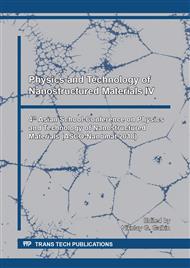[1]
Agarie S., Agata W., Uchida H., Kubota F., Kaufman P.B. Function of silica bodies in the epidermal system of rice (Oryza sativa L.): testing the window hypothesis // J. Exp. Bot. 47(298) (1996) 655-60.
DOI: 10.1093/jxb/47.5.655
Google Scholar
[2]
Bauer P., Elbaum R., Weiss I.M. Calcium and silicon mineralization in land plants: transport, structure and function // Plant Sci. 180(6) (2011) 746-56.
DOI: 10.1016/j.plantsci.2011.01.019
Google Scholar
[3]
Golokhvast K.S., Seryodkin I.V., Chaika V.V., Zakharenko A.M., Pamirsky I.E. Phytoliths in taxonomy of phylogenetic domains of plants // BioMed Research International 2014 (2014) 648326.
DOI: 10.1155/2014/648326
Google Scholar
[4]
Golokhvast K.S., Chaika V.V., Ugay S.M., Seryodkin I.V., Galkina A.N., Romashko R.V., Pamirsky I.E. The first data on silicon microstructures (mycoliths) found in the Inonotus obliquus fungus // Biology and Medicine 6(2) (2014) BM-023-14.
Google Scholar
[5]
Golokhvast K.S., Seryodkin I.V., Bulakh E.M., Chaika V.V., Zakharenko A.M., Kholodov A.S., Pamirsky I.E., G. Chung Mycoliths morphotypes and biosilification proteins in wood-destroying and pileate fungi // Botanica Pacifica 7 (2018) 1.
DOI: 10.17581/bp.2018.07102
Google Scholar
[6]
Kauss, H. Kai Seehaus, Rochus Franke, Sabine Gilbert, Robert A. Dietrich and Nils Kroger. Silica deposition by a strongly cationic proline-rich protein from systemically resistant cucumber plants. Plant J. 33 (2003) 87–95.
DOI: 10.1046/j.1365-313x.2003.01606.x
Google Scholar
[7]
Klančnik K., Vogel-Mikuš K., Gaberščik A. Silicified structures affect leaf optical properties in grasses and sedge // J. Photochem. Photobiol B. 130 (2014) 1-10.
DOI: 10.1016/j.jphotobiol.2013.10.011
Google Scholar
[8]
Madella M, Alexandre A, Ball T. International Code for Phytolith Nomanclature 1.0. ICPN Working Group. Annals of Botany 96 (2005) 253–260.
DOI: 10.1093/aob/mci172
Google Scholar
[9]
Piperno D.R. Phytolith analysis, an archaeological and geological perspective. Academic Press, San Diego, 1988. 280 p.
DOI: 10.1126/science.241.4873.1694-b
Google Scholar
[10]
Piperno D.R. Phytoliths: A Comprehensive Guide for Archaeologists and Paleoecologists. Lanham, Maryland: AltaMira Press, 2006. 238 p.
Google Scholar
[11]
Strömberg C.A.E. Evolution of grasses and grassland ecosystems // Annual Reviews of Earth and Planetary Sciences. 39 (2011) 517–544.
DOI: 10.1146/annurev-earth-040809-152402
Google Scholar
[12]
Strömberg C.A., Dunn R.E., Madden R.H., Kohn M.J., Carlini A.A. Decoupling the spread of grasslands from the evolution of grazer-type herbivores in South America // Nat Commun. 4 (2013) 1478.
DOI: 10.1038/ncomms2508
Google Scholar


